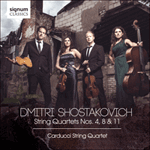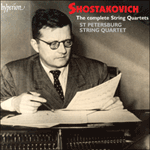
Welcome to Hyperion Records, an independent British classical label devoted to presenting high-quality recordings of music of all styles and from all periods from the twelfth century to the twenty-first.
Hyperion offers both CDs, and downloads in a number of formats. The site is also available in several languages.
Please use the dropdown buttons to set your preferred options, or use the checkbox to accept the defaults.

| Carducci String Quartet» More |
From earliest times to the present day the string quartet has lent itself readily to the composition of a work in more than four movements to a degree which only exceptionally rarely applies to symphonic composition; structurally it has more in common with the partita or divertimento. The violin, the instrument of the group dance, the village dance, the formal social event of the ethnic ‘folk’, was also the instrument of the dancing-masters and has always been a melodic instrument. The instrument’s sustaining power means that both very fast and very slow music are ideally suited to it and the other strings; the wide emotional range lends it naturally to multi-movement composition, either as a multi-movement work, or as parts of a one-movement work.
In the Eleventh Quartet Shostakovich links seven separate short movements in a structural homage to the genre’s roots. The link is the emotional plan. In some respects the Eleventh revisits the Tenth: the first violin opens the work with a series of melodically joined rising and falling (yet modally indeterminate) fifths, which finally settle in F minor. This has been described as a ‘motto’ theme, but it is more a sequence of phrases from which the composer takes that which he needs for the following movements. Thus the movements are separate in character but thematically unified. The Scherzo is conjoined, and the first violin opens again, unaccompanied, with another simple dance-like idea, which falls melodically in thirds, punctuated by intermittent rising glissandos (which texturally anticipate parts of the last four quartets).
An ominous low C on the viola leads to the short yet strongly dramatic Recitative, almost as if it were the musical personification of three heart seizures. In the Etude, the first violin and then the cello envelope the movement, against a simple repeated chorale-like figure, a device which is turned on its head in the Humoresque, wherein the second violin repeats just two notes throughout, G and E, regardless of what else is going on. As this peters out, an interval between them, F sharp, becomes—as F sharp minor—the tonal region of the Elegy, the emotional heart of the work. Perhaps significantly, it is the unaccompanied second violin that leads to the finale, outwardly a very simple piece, initially in F minor/major, but focusing as it progresses on the minor mode as the organic material of the work passes by in affectionate reminiscence until the first violin holds the highest possible C, seemingly forever.
from notes by Robert Matthew-Walker © 2002
Le quatuor à cordes se prête depuis toujours à la composition à plus de quatre mouvements, à un degré qui s’applique par ailleurs à l’écriture symphonique, et encore, rarement; dans sa structure, il a plus de points communs avec la partita ou le divertimento. Le violon, instrument de danse, de fête villageoise (événement social formel du folklore ethnique) est également l’instrument des maîtres de danse et fut toujours un instrument mélodique. Sa flexibilité sonore naturelle, tant dans le legato que dans le pizzicato, en font l’instrument idéal à la fois pour la musique très lente et très rapide; sa grande palette d’émotions le destine, ainsi que les autres instruments à cordes, à la composition à mouvements multiples, divisés en plusieurs mouvements différents ou regroupés en un long mouvement varié.
Nous notons, dans les quatuors de Chostakovitch, avec quelle ardeur le compositeur relève de défi d’une telle discipline de composition, et dans le numéro 11, va jusqu’à lier sept mouvements courts différents en un hommage structurel aux racines du genre. Le lien se situe sur le plan émotionnel. Le Onzième quatuor s’inspire dans certains aspects du numéro 10: à l’instar de ce dernier, l’œuvre s’ouvre au premier violon sur une série de quintes montantes et descendantes (mais indéterminées au plan modal) et liées par la mélodie, pour s’installer dans la tonalité de fa mineur. Cette caractéristique est comparée à un leitmotiv, mais il s’agit davantage d’une séquence de phrases musicales auxquelles le compositeur prend les éléments des mouvements suivants. Les mouvements sont donc distincts dans leur personnalité mais proches dans leur unité thématique. Le Scherzo est adjoint, et le premier violon fait encore une fois l’ouverture, sans accompagnement, à la manière d’une danse, qui retombe en tierces ponctuées de glissandos montants (ces traits anticipent, par leur texture, certaines parties des quatre derniers quatuors).
Un do menaçant à l’alto introduit un récitatif bref et néanmoins dramatique, comme s’il s’agissait de la mise en musique de trois attaques cardiaques. Dans l’Étude, le premier violon suivi du violoncelle enveloppe le mouvement sur fond d’un motif simple et répété à la façon d’un choral, technique reprise et inversée dans l’Humoresque, où le second violon répète simplement deux notes, sol et mi, dans tout le mouvement, obstinément. Alors que ce motif tourne court, l’intervalle qui sépare les instruments, le fa dièse, devient fa dièse mineur, la région tonale de l’Élégie, cœur émotionnel de l’œuvre. Il est sans doute important de noter que c’est le second violon qui mène le groupe au Final, morceau apparemment très simple qui progresse de fa dièse mineur et majeur pour s’imposer, dans la tonalité mineure, comme la réminiscence affectueuse de l’âme de l’œuvre, jusqu’à ce que le premier violon tienne le do le plus aigu possible pendant ce qui semble une éternité.
extrait des notes rédigées par Robert Matthew-Walker © 2002
Français: Marie Luccheta
Von seinen Anfängen bis auf den heutigen Tag wurde die Gattung des Streichquartetts ohne weiteres für die Komposition von Werken mit mehr als vier Sätzen genutzt, was auf sinfonische Werke nur außerordentlich selten zutrifft; vom Aufbau her hat das Quartett mehr mit der Partita bzw. dem Divertimento gemeinsam. Die Geige, das Instrument des Gruppentanzes, des dörflichen Tanzes, des offiziellen gesellschaftlichen Ereignisses „fürs Volk“ war außerdem das Instrument der Tanzmeister, und sie war schon immer ein Melodieinstrument. Dass dieses Instrument in der Lage ist, ausgehaltene Töne zu spielen, heißt, dass sowohl sehr schnelle als auch sehr langsame Musik ideal dazu und zu den übrigen Streichinstrumenten passt; seine breite emotionale Palette ist ihrem Wesen gemäß für mehrteilige Kompositionen geeignet, seien es Werke mit mehreren Sätzen oder Abschnitte eines einsätzigen Werks.
Im Falle von Schostakowitschs Quartetten haben wir vermerkt, wie er sich der beachtlichen Herausforderung der kompositorischen Disziplin gestellt hat und im Elften Quartett sieben eigenständige kurze Sätze miteinander verbindet—eine strukturelle Huldigung an die Ursprünge der Gattung. Diese Verbindung ist das emotionale Konzept. In mancher Hinsicht greift das Elfte auf das Zehnte Quartett zurück: Die Erste Geige leitet das Werk mit einer Serie ansteigender und abfallender (modal jedoch unbestimmter) Quinten, die sich schließlich auf f-Moll festlegen. Man hat diese Tonfolge als „Mottothema“ bezeichnet, doch ist sie eher eine Sequenz von Phrasen, denen der Komponist entnimmt, was er für die folgenden Sätze braucht. So kommt es, dass die Sätze zwar vom Charakter her eigenständig, aber thematisch vereinheitlicht sind. Das Scherzo ist eingebunden, und die Erste Geige macht wiederum unbegleitet den Anfang, auch diesmal mit einem schlichten tänzerischen Motiv, das melodisch in Terzschritten absteigt und in Abständen von ansteigenden Glissandi unterbrochen wird (die von der Textur her Teile der letzten vier Quartette vorwegnehmen).
Ein beunruhigendes tiefes C auf der Bratsche leitet zum kurzen, aber hochdramatischen Rezitativ über, das den Eindruck erweckt, als sei es die musikalische Umsetzung dreier Herzattacken. In der Etüde belegen die Erste Geige und dann das Cello den Satz mit Beschlag, vor dem Hintergrund einer schlichten wiederholten Choralfigur. Dieses Stilmittel wird in der Humoreske auf den Kopf gestellt; dort nämlich wiederholt die Zweite Geige ein ums andere Mal die zwei Töne G und E, ohne Rücksicht darauf, was sonst vorgeht. Nachdem sie sich totgelaufen hat, wird das dazwischenliegende Intervall Fis—als fis-Moll—zum tonalen Bereich der Elegie, die das emotionale Herzstück des Werks ist. Es ist wohl bedeutsam, dass es der unbegleiteten Zweiten Geige überlassen ist, zum Finale überzuleiten, das oberflächlich betrachtet ein sehr einfaches, anfangs in f-Moll/F-Dur angelegtes Stück ist, sich jedoch im weiteren Verlauf auf die Molltonart konzentriert, während das organisch zusammenhängende Material in zärtlicher Besinnung vorüberzieht, bis die Erste Geige das höchste mögliche C spielt und es scheinbar unendlich lang aushält.
aus dem Begleittext von Robert Matthew-Walker © 2002
Deutsch: Anne Steeb/Bernd Müller
 Shostakovich: String Quartets Nos 4, 8 & 11 Shostakovich: String Quartets Nos 4, 8 & 11The Carducci Quartet is recognized as one of today’s most successful string quartets. Here they present three of Shostakovich's fifteen quartets, including the powerful No 8.» More |
 Shostakovich: The Complete String Quartets Shostakovich: The Complete String Quartets‘These players approach Shostakovich's mighty cycle with a natural authority that's unanswerable, along with tireless precision and virtuosity, plus a ... ‘The St Petersburg musicians play with tremendous control of technique and expression; the effect is one of huge emotional strength’ (Birmingham Post)» More |

